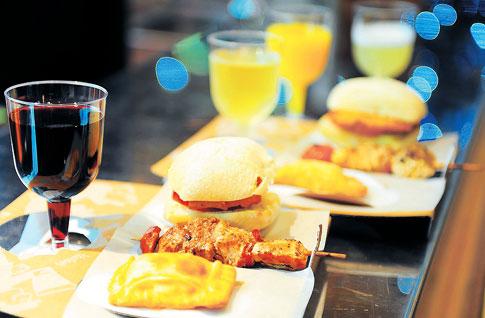 |
| Two snack combos in the Chile Pavilion. Each contains three types of traditional South American snacks - empanada, anticucho and churrasco.(Source: Shanghai Daily) |
BEIJING, Sep. 5 (Xinhuanet) -- After long hours visiting the World Expo, relaxing with South American-style food is restorative, as well as a new adventure.
We visited the Chile and Peru pavilions in Zone C and can confirm that the snacks, meals and grape brandy cocktails will definitely make you feel better.
The Chile Pavilion provides two snack combos, one with meat, the other with seafood. Each contains three types of traditional South American snacks -- empanada, anticucho and churrasco. But they make a meal for children and constantly dieting women.
An empanada looks like a fried Chinese dumpling, but not all are fried -- the beef empanada is baked. As you take a bite, the delicious meat juice from the thin wrapper flows into your mouth, just the way it does with Shanghai xiaolongbao (steamed buns). The empanada's flavors of meat and onion linger on the tongue and in the brain for a long time.
The anticucho is a brochette of vegetables and pork or salmon. Avocado is commonly used, though in China avocado is seldom cooked.
The churrasco is actually a sandwich and pavilion staff recommended the seafood churrasco containing fried fish, onion, tomato and mayonnaise, made especially for the Expo.
"In Chile, you are not able to find a fish churrasco," said Danielle Cartes, a pavilion official. "This is the chef's special recipe for Expo visitors."
The snacks are appetizer size, but the meat combo costs 64 yuan (US$9) and the seafood combo costs 68 yuan.
Tired travelers need a drink, like a pisco sour (from Pisco, Peru) with ice. The cocktail, 25 yuan, is made of pisco (grape brandy), lemonade and syrup, tasting a little sour but a little more sweet. The cocktail is only 14-15 proof so moderate drinkers won't get tipsy.
"I love pisco sour. I usually call the drink 'smiling lemonade' because it always makes me smile," said Cartes.
For those who want to sit down to a more formal meal, the restaurant in the Peru Pavilion offers a range of cuisine with influences from around the world, including Asia (China and Peru have long connections), Africa and Europe.
There's a variety of dishes, rice, salads and beverages. Peruvian-style stir-fried beef is very popular and is influenced by Chinese cuisine. The beef is tender, slightly spicy and tongue-tingling.
"I love the dish, because it's different from the Western-style food we know and a bit like Chinese food," said visitor Helena Yin.
"It's amazing we can find similarity in the food culture between the two countries that are so far away from each other."
If the Peruvian food is too spicy, visitors can cool down with dessert. There's ice cream and Peruvian-style fruit panacotta, which seems like pudding. Desserts cost 40-50 yuan.
(Source: Shanghai Daily)





